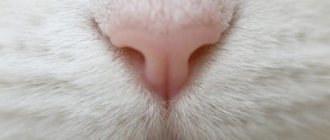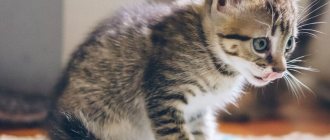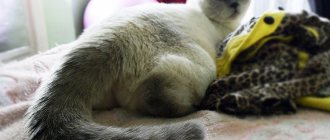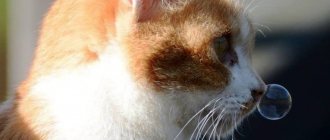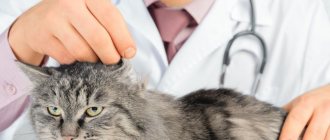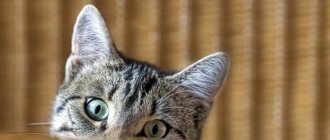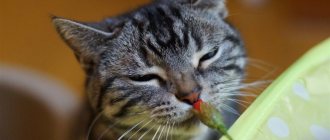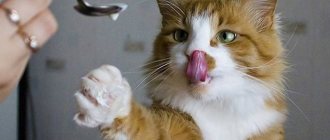What should a healthy cat's nose look like?
A cat's nose is a sensitive tool for exploring its environment. With its help, a pet can perfectly identify odors, because the sense of smell of these animals is 14 times superior to that of a human. The number of receptors in its olfactory organ can reach 80,000,000 (5,000,000 in humans). True, this system includes not only the nose, but also a special Jacobson tube located on the palate (which is why you can sometimes notice that the cat draws air into its mouth).
In addition, the nasal cavity has another function: warming and cleaning inhaled air from dust, germs and bacteria.
The nose, called a speculum, helps to set the temperature of an object even without touching it. When a pet sniffs the food offered for a long time, it determines not only its smell, but also how hot it is. A mirror can tell a lot about possible disturbances in the functioning of an animal’s body.
In a healthy cat, in a calm state, the nose is slightly cool, moist, slightly shiny, and has no scales or crusts.
The speculum becomes moist because the secretion of the mucous membranes is released. It retains molecules of foreign substances to accurately detect odor and creates a protective film from exposure to adverse factors. In addition, the cat constantly licks its nose, which additionally moisturizes it.
The nose (mirror) should be free of dirt and crusts
But if you feel that your pet’s nose is dry and hot, there is no cause for concern yet.
What signs may accompany a dry and warm nose?
You can guess the reasons for changes in the condition of the nose by the accompanying signs. If any of them indicate pathology, you should immediately consult a doctor. Let's list the main features.
Loss of appetite
Usually indicates that the pet is weakened. If he has a disease of internal organs, inflammation, or has caught an infection, then in addition to low appetite, this will be indicated by apathy, prolonged sleep and high temperature.
If the temperature is normal, it is worth remembering whether there has been anything recently that could cause stress in the cat. If this is the reason, the pet should be surrounded with attention, and it will quickly return to normal.
Ears too warm
If not only the nose is hot, but the ears too, then the cat has hyperthermia. The reason may be:
- colds or otitis media;
- trauma, hematoma;
- viral infection;
- stress;
- staying in a room that is too warm and stuffy for a long time.
Some of these reasons can be eliminated on your own, but in some cases you will have to go to the doctor.
Nose changed color
If the nose has acquired a bluish tint, this may be a sign of intoxication, yellow - kidney failure, redness indicates a burn, and pallor - a heart pathology.
Other symptoms
If the cause is a viral infection or damage to the gastrointestinal tract, vomiting and diarrhea are possible. If blood is visible in the vomit or stool, you should consult a doctor immediately, because this indicates damage to internal organs.
You can also determine something by the color of nasal discharge: it can be transparent, contain pus or sulfur. If your cat has a cold, its eyes may become red and breathing may become difficult. When infested with parasites, the quality of the coat deteriorates and it begins to fall out.
If the animal suddenly loses weight, has anemia, difficulty breathing, convulsions and paralysis, the cause may be a malignant neoplasm. A wobbly gait and increased salivation should also be a reason to consult a doctor because it indicates damage to the nervous system - its consequences can be very serious.
Why can a cat have a dry and hot nose?
A cat's nose becomes hot as body temperature rises and blood pressure rises. This can be both a sign of a disease and a physiological reaction of the body to certain situations.
A natural reaction may occur in the following cases:
- With a lack of fluid in the body. This is possible if there is no water for the cat or if the humidity in the room is low. Too high an ambient temperature can cause heat stroke in an animal. Therefore, you need to protect your pet from such a situation:
- ventilate the room in a timely manner;
- be sure to provide cool water in case of prolonged absence;
- Do not leave your pet in the car in hot weather.
- During times of increased activity, when the body loses a lot of fluid due to movement.
- In any stressful situation, even seemingly insignificant:
- long absence of the owner;
- arrival of guests;
- the appearance of a new pet;
- visiting a veterinarian;
- taking medications;
- hygiene procedures.
- After a long sleep, especially if the cat slept in a warm and dry place. At this time, the secretion of the mucous membranes is not produced and the speculum dries out.
- An increase in temperature may occur during the period of estrus, but in this case her behavior indicates the cause of the heat: she fawns, puts her rump aside, and meows loudly.
A slight loss of moisture should not affect the health of the pet. If he looks good, is active, and does not show any other symptoms of the disease, then there is no reason to worry. But it is necessary to continue to monitor the condition of the nose.
Video: why does a cat have a hot nose or ears
Pathological causes of fever in a cat
A pet's dry, hot nose for several hours may indicate illness. It is necessary to carefully examine the animal to try to determine the cause of the illness.
Examination of mucous membranes
Changing the color of the nasal mirror, like other mucous membranes, can help in determining the area of pathology. It occurs in the following cases:
- increased pallor appears with hypothermia and poisoning, and it also appears with anemia - a lack of hemoglobin in the blood;
- cyanosis of the skin and mucous membranes occurs when there is a lack of oxygen in the tissues, which may indicate a malfunction of the cardiovascular system;
- a reddish tint to the nose indicates an infectious disease, including rhinitis, and this color is also possible with high blood pressure, allergies or injury;
- a yellowish color appears in case of liver problems.
Diagnosis of changes in the color of mucous membranes is easy to carry out if the nose mirror is light, and black cats will have to examine the inside surface of the mouth.
The pale mucous membrane of the oral cavity may look like this
By examining the mucous membrane of the mouth, you can check the functioning of the circulatory system. To do this, you need to press on the surface and then release. The white spot that appears when pressed should disappear within 2 - 3 s. If this does not happen, there are problems in its functioning.
Pulse detection
Pulse is an essential indicator of health status. To calculate it, you need a stopwatch or a watch with a second hand. In cats, the pulse is best felt in the femoral artery, which is located on the inside of the limb. To find it, you can follow the suggested instructions:
- lightly press with your fingers at the point where the artery passes to feel the pulsation of the blood flow;
- note the time on the stopwatch, and within 10 s. count blood pulses;
- multiply the resulting result by 6, this will be the pulse rate - the number of beats per minute.
A cat's normal heart rate is between 120 and 140 beats/min. But in large breeds of cats it is a little slower, and in small kittens it can reach 190 beats per minute.
Hand position when determining a cat's pulse
The pulse changes in the following cases:
- with an increase in body temperature, emotional arousal, during the period of searching for a mate, the pulse increases;
- inflammation of the heart muscle (myocarditis) can cause both a slower and faster heart rate;
- Poisoning at the initial stage causes a strong heartbeat, and then the pulse drops below normal.
Temperature detection
An important indicator of a cat's health is body temperature. The most reliable indicators include the rectal method of measuring it (in the anus). An ordinary thermometer is suitable as a measuring device, but the duration of the procedure depends on its type:
- 6 minutes is required when using a mercury thermometer;
- 3 min - for its universal electronic analogue;
- 10 s - when using special rectal thermometers.
An electronic thermometer is also safer, since there is always the possibility of damage to the mercury flask and poisoning by its contents.
How to measure a cat's temperature
It is better to carry out the measurement procedure with an assistant to make it easier to hold the animal:
- prepare the thermometer by lubricating its tip with Vaseline or another emollient;
- secure the cat on a hard surface (or wrap it in a towel and hold it under your arm);
- the thermometer is slowly inserted into the anus about 2.5 cm;
- performing calming movements, you need to keep the cat in a motionless position for the required period of time;
- evaluate the measurement result, disinfect the thermometer and place it in your pet’s first aid kit.
The normal temperature of a healthy cat is 38.5°C. The following indicators are dangerous:
- below 37.8°C - such indicators can be due to hypothermia, problems with the endocrine system or bleeding;
- 39.2 - 39.5°C - high temperature, indicating the presence of pathology;
- over 41°C - a state of heat stroke, you must urgently contact a veterinarian and take measures to reduce the temperature until the doctor arrives:
- place the animal in a cool place;
- provide a flow of fresh air;
- apply ice;
- wash with cold water or, as a last resort, immerse the pet in it completely.
Video: how to measure an animal's temperature
Other factors to determine your pet's condition
You need to pay attention to his behavior. This will help with diagnosing the disease and providing first aid. Important symptoms are:
- the general condition of the animal, its activity and response to external stimuli;
- functioning of the digestive system, frequency of urination;
- weight change;
- attitude towards food and water;
- condition of the skin, fur, mucous membranes.
It is best to not only remember these indicators, but also write them down. Then, when contacting a veterinarian, the description of the animal’s condition will be more complete.
Table: diseases characterized by fever
| Pathology | Additional symptoms |
| Feline distemper | This disease leads to the death of the animal in 90% of cases; in addition to high fever, it is accompanied by:
|
| Severe viral diseases, including calcevirosis and rhinotracheitis | In addition to high temperature, other signs are possible:
|
| Viral and bacterial infections, worm infection |
|
| Poisoning |
|
| Pneumonia |
|
| Diseases of the nervous system of an inflammatory nature (encephalitis, myenitis) | These diseases are often the result of infectious diseases or injuries. Accompanied by neurological disorders:
|
| Acute inflammation (abscess or phlegmon) | There is an open or intermuscular cavity with pus on the animal’s body. On palpation, swelling may be detected; the animal reacts painfully to touch. In addition to high fever, other symptoms may appear:
|
| Purulent otitis media | In addition to fever, ear inflammation may be accompanied by:
|
| Allergic dermatitis and rhinitis, bronchial asthma | The temperature is slightly higher than normal, in addition to this there are other signs:
|
| Endocrine disorders. | Changes in temperature are minor, but other symptoms are possible:
|
| Mastitis in cats | This inflammatory process may be accompanied by:
|
The list of diseases that cause fever is long. Each of them has its own cause and, accordingly, its own treatment regimen. An accurate diagnosis can only be made after a doctor’s examination and diagnostics. If a high temperature is detected in a cat, it is recommended to immediately contact a veterinary clinic.
It is necessary to know the main signs of the most serious diseases so as not to harm your pet in extreme situations and contact a specialist in time.
Cat owners have already become accustomed to determining the health/illness of their beloved mustachioed pet by the condition of its nasal planum. This is partly true. But a dry nose in a cat is not always an indicator of poor health. When should we start sounding the alarm, and when is it enough to just wait a while, and everything will become damp and cold again without outside intervention? Why does a cat have a dry nose?
When hot ears can be a symptom of illness
Hot ears and nose in a cat are not a clear sign that proves the presence of pathology in the animal’s body. To assess your pet’s health, it is necessary to take into account other clinical symptoms, which include:
- change in the shade of the ear (redness, pallor, cyanosis);
- loss of appetite or complete refusal to feed;
- lethargy;
- decreased activity;
- increase in general body temperature.
If one or more of the listed symptoms is present, then the owner needs to find out what it might mean when a cat has hot ears.
Experts identify several pathological factors that lead to a cat's ears becoming hot.
Stress
When cats are stressed, there is a sharp release of hormones into the bloodstream, which leads to an increase in heart rate and increased blood pressure. As a result of accelerated blood flow, the ears of a kitten or adult animal turn red and become hot.
As the pet calms down, its condition and appearance return to normal.
However, prolonged stress will be accompanied by changes in behavior. The cat may become aggressive, nervous, or overly withdrawn. Gradually, this will provoke the development of pathologies of the nervous system, and will also lead to a decrease in immunity.
Ear mite
The cause of hot ears in a cat may be the ear mite Otodectes cynotis. The disease it causes is called otodectosis. Feeding on sulfur and scales of dead epithelium of the external auditory canal, the parasite releases waste products that irritate the skin and cause severe itching.
The cat itches and hits the ears with its paws, which often leads to the appearance of bruises. Other characteristic symptoms of otodectosis are:
- red and hot ears of the cat;
- tarry dark brown discharge from the ears;
- scratches and ulcers;
- anxiety;
- decreased appetite.
Important! Ear mites can affect either one or two ears. But it is necessary to treat both ears at the same time to prevent the spread of the disease.
Most owners know that hot ears on their pet mean they have cat ear mites. However, only a veterinary specialist can make an accurate diagnosis after examination and microscopic examination of the pathological material.
Otitis
With otitis media, inflammatory processes occur in the auricle, which also affect the middle and inner ear. This disease is caused by bacterial pathogenic microflora.
The first sign of otitis media is a deterioration in the pet’s general health. The cat's appetite decreases, the ears and nose become hot, the animal is lethargic and the owners do not know what to do to alleviate the condition. But at the next stage of the disease, characteristic clinical symptoms of otitis media appear, which make it possible to make a diagnosis and begin treatment. These include:
- pain in the ear area (usually worsens when touched);
- hyperemia of the inner surface of the ears;
- refusal of food;
- purulent discharge from the ears.
With unilateral otitis, the cat tilts its head towards the affected organ, sometimes shakes it, and hits the ears with its paws.
Gradually, the general body temperature may rise above 39°C. Lack of treatment leads to inflammation spreading to the membranes of the brain and death.
Trauma and hematoma
If your cat's ears are red and hot to the touch, this may indicate a hematoma. It may be the result of an injury caused by a blow or compression of the auricle. Also, a pet can provoke damage to blood vessels on its own by hitting it with its paw during severe itching or pain.
A characteristic sign of a hematoma is the absence of any discharge from the ears. On palpation you can feel fluctuation.
Unlike other diseases, with a hematoma there is no discharge from the ears. Also, despite the hot ears, the cat’s nose remains wet.
Infections
The cause of hot ears and noses in kittens and adult cats may be infections of bacterial and viral etiology. Only a veterinarian can determine exactly why a cat has a dry and warm nose.
However, owners need to pay attention to the following signs, which are common to all infectious pathologies:
- sudden loss of appetite or anorexia;
- fever;
- inactivity;
- apathy;
- vomiting, diarrhea and other signs of intoxication.
If the kitten is hot or has discharge from the nose or eyes, this means that the baby must be urgently sent to the clinic.
Other diseases
A cold can cause your cat to have a dry, warm nose. The animal experiences lethargy, decreased appetite, and increased body temperature. At the first stage, the cat’s nose is warm, the mucous membrane of the nasal cavity is noticeably dry, and the ears become hot.
Next, transparent serous discharge appears, which is gradually replaced by mucous discharge. Coughing, sneezing, and heart rhythm disturbances may develop.
A dry nose in a cat may be one of the signs of urolithiasis. In this case, there is an increase in blood pressure and the appearance of blood in the urine. In the absence of urination, urgent hospitalization of the animal is necessary.
If the cat is healthy
In healthy baleen predators, the condition of the nose varies depending on many factors. A cat’s nose becomes dry or wet depending on the physiological state of the animal - this organ is never constantly wet and cold. Those. A cat's nose is dry and warm even in a normal physiological state. The only question remains is the environmental conditions and the period of time when it becomes wet again.
A cat's wet and moist nose allows it to determine the direction of the wind in order to hide its own scent from those it plans to hunt. A dried out organ can no longer perform such functions.
When a warm, dry nose is considered normal:
- the cat is sleeping or has just woken up (must moisturize within half an hour after sleep);
- period of increased physical activity - running, jumping, pampering with the owner;
- dry air in the home or the cat was near warm heating appliances for a long time;
- sudden fear, stress;
- prolonged exposure to the open sun (literally dries out);
- the nasal planum is dirty (the ability to secrete nasal secretions is lost).
Dry, hot noses in kittens throughout the day are much more common than in adults. This is explained by an imperfect thermoregulation system and should not alarm owners if the kittens are outwardly healthy, active and have a good appetite. This is a kind of self-defense against possible hypothermia of mustachioed babies.
Actions to take if you suspect your pet is sick
You can try to reduce the temperature in the following ways:
- ventilate the room
- wet the wool with water,
- apply cold compresses to the armpits.
It is important to avoid dehydration. If the cat does not drink, it should be given water through a pipette or syringe. If crusts have formed on the lobe, use chlorhexidine or furatsilin to soak them. If your pet's condition does not improve, you should seek help from a doctor.
Antipyretics should not be given to cats unless prescribed by a doctor. Many drugs intended for humans are toxic to cats; their use will result in allergies or even poisoning, and if the animal is already sick, its condition can greatly worsen.
But you shouldn’t panic as soon as you discover that your cat has a dry and warm nose. First, just watch her, if there are no other signs of illness, perhaps everything will soon return to normal. But if you notice them, you should not hesitate to consult a doctor.
When a dry nose should alert you
If the nasal planum has dried out, and this symptom is accompanied by other manifestations, then you need to pay special attention to these symptom complexes. A hot nose in a cat should alert you if this fact has been observed for a long time (for example, it is constantly dry throughout the day).
The following accompanying symptoms should attract attention:
- the cat/cat is lethargic, apathetic, practically does not eat anything, does not want to play;
- Thirst may occur (due to dehydration, secretion ceases to be produced, which makes the nose wet);
- sleep a lot and for a long time (it seems that the animal sleeps around the clock);
- along with a hot nose, the cat has noticeably hot ears (usually this is a sign of elevated temperature);
- rapid shallow breathing (normal is from 16 (18) to 33 respiratory movements per minute) or accelerated heartbeat (normal pulse is 100-120 beats/min in adults, up to 140 beats/min in kittens);
- on the contrary, slow and deep breathing;
- nasal discharge of any kind and sneezing;
- any changes in color (blue, yellowish, intense red or white, almost discolored).
If a warm and dry nose is accompanied by the following signs, then this is already a reason for a mandatory visit to the veterinarian (especially if the signs are pronounced):
- there are changes in the frequency of visiting the toilet, and it does not matter whether it is more frequent or, conversely, less frequent (on average 1-2 (3) times a day defecation, 2-3 times a day urination);
- change in the condition of feces - usually towards diarrhea (especially if with bloody impurities);
- nausea (the cat begins to lick itself frequently, because at the moment of nausea the secretion of saliva increases) or obvious vomiting is observed;
- the fluid secreted from the nostrils is opaque, with an unpleasant odor;
- body temperature rose to 40C.
Dry nose as a sign of illness
A normal cat's nose is cold and wet.
Kittens develop dry nose more often than adult pets. This is due to thermoregulation, since a small body cools down faster (for example, after active games). Sometimes a dry nose becomes a sign of illness. More often this is accompanied by other additional symptoms. A hot, dry nose is a sign of dehydration. You should be concerned if it remains like this for longer than 2-3 hours, even when there are no other symptoms of the disease.
Signs of the disease other than “ dry nose ”:
- lethargy, apathy;
- decreased or lack of appetite;
- high ear temperature;
- rapid breathing (normally it is 16-18 breaths per minute);
- strong thirst;
- change in color of mucous membranes (any deviation from pink);
- rapid heartbeat;
- sneezing, coughing;
- the appearance of exudate (snot) of different colors and viscosity.
A dry, hot nose indicates a serious pathology if there is a violation of the stool. The normal frequency does not exceed 1-2 times a day. With diarrhea and constipation, the pet’s abdomen is very tense, and pain occurs on palpation. The stool may be liquid, dry, cracked, or green, black, or red. Normal – without impurities (food residues, blood, worms and their eggs, sand).
Pathologies are often accompanied by constant nausea and vomiting. Nasal exudate has an unpleasant odor. During illness, the temperature rises: in kittens – from 40 °C, in adult cats – from 39 °C. As soon as these symptoms appear, you need to urgently take the animal to the veterinarian.
If the color of the mucous membranes changes due to dryness of the nose:
- pallor indicates cardiovascular diseases, hypothermia, internal bleeding, intoxication of the body;
- redness occurs due to mechanical damage (if additional exudate appears, it indicates rhinitis, otherwise sepsis or an infectious lesion can be suspected);
- blueness and severe shortness of breath occur with diseases of the cardiovascular and respiratory systems (often the pathology is accompanied by coughing and severe wheezing).
If a dry nose lasts longer than 2-3 hours, the animal becomes lethargic. This occurs due to an increase in normal temperature by more than 1 degree. Lethargy and lack of appetite accompany the fever.
Why does my nose feel dry and hot?
If the physiological causes of drying and warming of the nose are discarded and the time period during which this fact is observed begins to be alarming, then the cat is definitely sick. The exact cause and diagnosis can only be made by a veterinary specialist after an in-person examination and passing the necessary tests on the animal (if necessary).
Possible causes of a dry and hot nose:
- internal infections (viral or bacterial);
- inflammatory process of any localization;
- fur in the stomach or intestines;
- dehydration due to diseases or unfavorable conditions in which the cat is kept;
- urolithiasis and any kidney pathologies;
- cat colds;
- nasal injuries;
- poisoning or digestive disorders.
How can I help my pet?
What to do if your cat has a dry nose? Of all the possible reasons for which the olfactory organ is hot and dry, owners of mustachioed pets can only try to normalize the body temperature, because... with this symptom it is most often increased. It is better not to engage in self-diagnosis and self-medication, because... There are many different reasons for this condition; it is almost impossible for a non-specialist to determine the exact cause! Measuring the temperature is the first and most important thing that a pet owner should do when they notice a long-term warm and dry nose.
It is strongly recommended not to treat fever in cats (up to 40C) with medications. Three main points for reducing body temperature without medication: give the cat cool (not cold!) water, wet the fur, and apply something cold to the groin and armpits. Any other assistance should already be provided by a veterinarian after an accurate diagnosis has been established.
Actions of the veterinary clinic
When contacting a veterinary clinic, the doctor first acts as follows:
- Conducts a general clinical examination;
- Measures body temperature;
- Collects information about the history of the disease;
- Takes urine and blood tests.
The main causes of dry nose in a cat are benign and malignant formations in the nasal sinuses, mechanical injuries (for example, a foreign body), chronic runny nose or viral infections. Depending on what pathology the doctor identifies, a course of treatment, and possibly a whole range of treatment procedures, is prescribed.
Question and answer: if the nose...
very cold but pale
Typically, this condition is accompanied by a lack of appetite due to poisoning, and can also be a sign of hypothermia or internal chronic pathologies, including problems with the heart. Stress and shock also cause a cat's nose to turn pale (but do not dry it out).
warm and white
The problem clearly lies in dysfunction of the hematopoietic and circulatory systems. A visit to the veterinarian is required.
hot and intense pink/red
Perhaps there has been a bruise of the nasal planum, infectious diseases are present, or there is rhinitis (both infectious and allergic in origin).
hot and very humid
When there is a transition from a dry state to a wet and cold state, the nose first becomes wet and then cools down. If this state does not last long, it means that everything is going as it should - the owners just got to the moment when it still had time to cool down. But if the condition is prolonged and the nose remains hot but wet, you need to measure your body temperature, perhaps it has increased.
blue or blue-violet plus hot
This is the first sign of oxygen starvation and/or heart failure, when an acute lack of oxygen in the tissues of the body is detected. Inflammatory processes in the lungs can also contribute to a blue nose in a cat.
dry and lethargic
Any sign that complements a dry and warm nose indicates that the pet is unhealthy. The task of the owner of a mustachioed pet is to determine the body temperature and seek the advice of a veterinarian to find out for sure what happened to the animal.
hot ears and dry nose
A classic manifestation of increased body temperature. If the ears become noticeably hot and dryness of the nasal planum is noticed, be sure to measure the temperature (rectally)!
the cat does not eat and the nose is dry
It is also a clear sign that the animal is unhealthy. The reasons range from poisoning to serious infections. A veterinarian will help you better understand the cause.
There are many reasons why the nasal planum gets warm and dries out. Not all of them are associated with any diseases. If, with such a symptom, the cat feels great, and nothing in its behavior alarms the owner, it makes sense to simply wait a while until the nose becomes wet and cold on its own. However, any of the accompanying signs of abnormal health is a clear reason to visit a veterinarian!
When a person gets sick, they always touch his forehead: isn’t it hot? In animals, this function of a sensor of well-being is performed by the nose, because they do not sweat through the skin, and heat manifests itself differently.
The respiratory system plays a significant role in thermoregulation: moisture evaporates from the nose and cooling occurs.
Cats are always looking for warmer places
A cat has a dry and warm nose: when is this a sign of illness?
Sometimes a cat has a dry and warm nose - this is a harbinger of a serious illness. Sometimes the illness turns out to be very serious. The nose becomes dry in the following cases:
- Gastrointestinal disorders. A cat can be poisoned by stale, bad food, this can happen after taking antibiotics. In this case, the cat’s nose becomes dry, its body temperature increases, and the cat may be accompanied by vomiting, loose stools, and weakness. The pet may refuse food altogether.
- Infectious, viral, bacterial disease. In addition to the fact that your pet's nose may become dry, his body temperature may increase, he may be bothered by a fever, and have loose stools. The cat may sneeze, refuse food or water.
- Diseases caused by ticks . The cat often begins to scratch his ears and muzzle, shake his head, behave restlessly, and refuse to eat. In this case, as a rule, the animal’s skin becomes inflamed, thickens, the skin in the head area becomes bald, its temperature rises, and its nose becomes dry.
- Cold - the cat's ears become hot, his nose becomes dry and cool. Body temperature increases, the animal weakens.
Maybe due to workload
- Note that a dry spout almost always has the same temperature - minimum +39.5°C and maximum +40°C. What can cause hyperthermia? There can be quite a few reasons: the presence of cancer, failures in the functionality of certain organs.
- The nose may become dry if the cat has worms, which poison the animal's body. In addition, there are cases when a cat suddenly develops a fever, but he still feels healthy.
- To help you understand whether your cat is sick or completely healthy, check his nose for moisture. Be sure to pay attention to what temperature your pet’s nose is and what condition it is in. Is the cat bothered by vomiting, diarrhea, does the animal refuse to eat, does it have discharge from its eyes, nose, and so on. If your animal’s nose is constantly dry, or other alarming symptoms arise, then immediately take your pet to the veterinary clinic.
- If your pet's nose is even hot (you feel this at the first touch), and the animal itself looks weak, this is very serious. The kitten's temperature may rise significantly. Don't wait, take your pet to the doctor immediately.
Disease
A similar thing occurs in domestic animals during a viral infection. And such diseases, as a rule, can be dangerous and lead to death. To avoid this, you should do the following:
- Place the cat in a room that is well ventilated. Just make sure there are no drafts. The ideal room temperature in this case is +20°C.
- Give your pet plenty of water. You can add a little sugar to it.
- Call your veterinarian.
Household causes of dryness
However, even a dry nose in a cat is not always a cause for concern. It can become wet or dry several times a day for many reasons, as long as the dryness is not constant. It is more advisable to assess the general condition of the pet. There are a number of factors that are not related to health problems:
- the animal has just woken up or is completely inactive. During sleep, metabolic processes slow down, and so does the release of moisturizing secretions. You should wait and check the spout again after about half an hour;
- the animal was actively playing. Body temperature and blood pressure increased, and moisture dried up. Before worrying about why the kitten has a dry nose, you need to let it catch its breath and touch it again;
- too much heat in the room or sleeping on a radiator. The liquid evaporated naturally. If the cat otherwise feels well, there is no lethargy, nausea or difficulty breathing, just give him a bowl of water. If, even in the stuffiness, the animal does not drink at all, although it is clear that it is hot, there is a reason to show it to the veterinarian. As for the batteries, it is worth laying a blanket or towel on them to prevent overheating of the cat’s internal organs. Due to the peculiarities of his anatomy, he can sleep for a long time on a hot bed, but the consequences of such sleep are serious;
- dehydration. This problem may be more serious than ordinary thirst. With parasitic diseases, it becomes truly dangerous, sometimes even fatal for a weakened body. A healthy cat can simply be given something to drink, but a sick cat needs qualified help;
- stress. A scared cat's nose dries out, this is the body's reaction. There are many reasons for cat anxiety: loud noises, transportation, strangers around. After the animal calms down, everything will return to normal;
- old age. A decrease in metabolic rate and a general deterioration in well-being affect everything. In the absence of a specific disease, it is hardly possible to help with anything. Probably, the dry nose is only associated with the low activity of the elderly animal;
- small age. Thermoregulation in a kitten’s body is still very imperfect, so the nose becomes warm more often than in adults. In order to protect against infections, the body temperature of babies is increased, and their activity is off the charts. A nimble kitten that has just hung on a curtain can hardly be suspected of health problems;
- recovery after medical intervention. In such a situation, a combination of factors is at work: both emotions and poor health. Once the patient leaves, everything will be fine. A typical example is sterilization, after which the cat’s nose can remain dry and warm for several days.
The cat has a dry and warm nose: what to do at home?
If your cat feels fine and nothing serious has happened to him, you can help your pet yourself. We offer you special measures that will be useful to you if your cat has a dry and warm nose.
- The cat's nose is dry and dirty. If you don’t clean your cat’s nose, it can become dirty, after which it will be difficult for the pet to breathe and the physiological lubrication of the nose will decrease. As a result, thermoregulation will be disrupted and the nose will be hot.
- Carefully clean the dirty spout from the outside and inside. Be careful not to damage sensitive tissue. After approximately 20 min. you will notice that your cat's condition returns to normal.
- Burn from strong sun rays. Every cat loves to sleep in the sun. But prolonged sleep under strong rays of the sun does not bring any benefit. Situations with burns are much more common than expected. This is especially true for those individuals who have a delicate pink nose.
- In a cat that has received a sunburn, the nose becomes red, hot, and the pet feels pain at the slightest touch. Over time, the skin on the nose becomes rougher, it becomes dry and rough. In this case, treat the cat’s nose with an anti-burn drug that has moisturizing and anti-inflammatory properties. Apply the product carefully so that it does not penetrate the nostrils. Repeat the procedure again until the nose looks normal.
Treat your nose
- Allergic reaction to chemicals. Many pets can have allergies. Don't forget about this when cleaning the house. If you do not wash the product well, it can cause great harm to the cat, who likes to poke his own nose into every corner.
- Urgently carry out another wet cleaning. Wash all surfaces thoroughly with clean water. Wash away any remaining chemicals that may cause irritation or allergies in your cat. Also does not include consultation with a veterinarian. He will tell you which antihistamine can be given to your pet and in what dose.
